Written by Michael Beisty
Joanne Cowan’s story is one of persistence underpinned by a love of running that has never been extinguished. Though primarily a road runner, and specialising in the marathon, Jo competed in a range of distances on the track, road and cross country. A late bloomer, Jo raced well in her mid-thirties and into her forties, and continued to race competitively for the next two decades. Jo set a high standard for master’s women distance running in Australia that has largely gone unnoticed. For Jo age wasn’t a factor. Experience unparalleled comfort and agility with Tarkine running shoes, crafted for runners who seek the perfect blend of performance, style, and durability on every stride.
Jo was fortunate to gain Australian selection in international road racing events and win overseas trips as a result of her efforts in major marathons in Australia. She ran 17 marathons in her career, her first one in 1989 at age 33. Jo was always ‘thereabouts’ and raced close up and personal against many of Australia’s best women such as Kerryn McCann, Heather Turland, Susan Hobson and Tani Ruckle. Jo was part of a fast-improving wave of elites who made its mark during the nineties, pushing for greater legitimacy of women’s distance racing, track and road, post Lisa Martin. She consistently ranked in the top 10 for the marathon and half marathon in Australia.
After meeting Jo at last year’s Sydney Striders 40th anniversary bash, I took the opportunity to probe into her life of running and what it meant to her. This wasn’t an easy task. Upon researching Jos’ background, I discovered that she is a NSW institution, having competed over many years in such iconic events as the Sydney Striders Half Marathon, Sydney Morning Herald (SMH) Half Marathon, City to Surf, and the Canberra and Gold Coast Marathons. Making the job easier for me, Jo advised that she is an ‘open book’ volunteering full disclosure of her circumstances.
So, in turning the pages of her running life, I trust you will enjoy reading her story as much as I enjoyed hearing first hand what it was like for Jo to compete against some of the best.
- Career Highlights
Jo had a long mainly injury free career. Her range of ability is evidenced by her personal bests of: 5000 metres track 16:29.61 (age 39), 10,000 metres track 34:28.71 (38), City to Surf 50:26 (37), half marathon 76:17 (36), and marathon 2:40:13 (38). Jo thought she may have run around 4:40 for a 1500 but was a bit hazy on the details. Subsequent trawling of Athletics Australia Almanacs unearthed performances of 4:33 for 1500 metres and 9:42.1 for 3000 metres in mixed races during the 1996-97 track season at 41 years of age.
Jo identified her career highlights as race performances in the Tokyo Half Marathon, her ongoing relationship with the Canberra and Gold Coast Marathons and the City to Surf, three appearances in the Zatopek 10,000 metres (‘my fastest was special’), various performances in NSW 10 km road titles (including a win over Sylvia Rose in 34:52, age 41), and achieving her 5000 metres personal best (PB) finishing second to Kerryn McCann in the 1995 NSW Championships, easily beating Heather Turland.
- Some Personal Information
Jo has a lengthy employment background in the hairdressing and hair products industry. The last 21 years Jo has been employed full time as a consultant in a publishing house (business to business industry media) associated with INSTYLE. She has a Masters in Marketing and lectures at Torrens University, a private education institution at Ultimo, an inner-city suburb of Sydney. She has a lifelong curiosity about the natural world and intends on pursuing this interest once her employment ceases.
Jo became a vegetarian at 28 years of age, her only meat foods being fish. At times training placed heavy demands on her body and she required injections to counter fatigue arising from deficiencies in Vitamin B12.
During 2020 Jo had heart surgery for a faulty valve and since then has gradually phased some light running back into her life. It’s something she is not prepared to let go, the sheer joy she feels from movement. Now 67 years of age, Jo stated that post-surgery she had become a ‘sloppy runner’ but upon reviewing her technique she is now running much better. ‘Engage the glutes more, increase the stride length and lift the body’ was her solution! Once a runner, always a runner.
- Early Days
Jo’s introduction to running occurred by happenstance. Supported by family members, school teachers and work colleagues along the way, Jo meandered through her younger running years with vitality and enthusiasm, sustained by a love of running. It was an organic development.
Jo was born in in Elwood, an inner suburb of Melbourne. During the 1960s she ran at primary school, at one time winning a State 4×100 metres relay championship. As a young girl Jo spent these early years in Sale in the Gippsland region of Victoria, where she attended St Annes, a private boarding school for girls. Her mother, Beth, was the school secretary, and her aunt was the headmistress. The family lived on the school grounds while her father, Frank, started up a business. It was during this period that she was introduced to cross country running around ‘the lake at Sale’. Jo was a free spirit and would ‘go running around the oval’ during school breaks.
Jo notes that she was never allowed to race further than 400 metres. One year she won the school cross country race that combined primary and secondary school students. Her sports mistress thought she had some natural ability and motivated her to train more frequently, ‘though I didn’t do much.’ It was during this time that Jo found her love of animals, the school holding sheep, cattle, dogs and chooks and teaching their students some basic animal husbandry.
After primary school Jo continued to run on an informal level and finished her secondary schooling during 1973 in Melbourne. Following a couple of years as an apprentice hairdresser and a six months European trip, Jo returned to Melbourne in 1977, relocating to Sydney in 1979, eventually settling in North Ryde. The relocation related to her managerial employment with Redken, a hair products firm. She married Jim in 1981, and in 1984 they made their home in French’s Forest where they still reside. While Jim is a non-runner, he has always assisted Jo’s athletic endeavours.
Reflecting on the period 1979 to 1984, Jo recalls how little she knew about training and racing. Whilst she loved the expression of running, she had no structure in her training and was drifting between aerobics, light exercise and casual running. Upon arriving in Sydney, she didn’t know anyone and over time made friends with workmates at Redken. She also made new friends at a local gym. They told her they were going to run the City to Surf and Jo was invited to join them. She ran around 60 minutes on limited training, and with no speedwork. ‘I didn’t have a clue’. However, this was ‘fast enough to get me into the preferred/seeded entrants for 1980.’
Upon moving to French’s Forest, Jo connected with a neighbour who also ran and invited her to weekend distance runs in Garigal National Park. This neighbour and some of his friends had an association with the Harbord Diggers Club. Many enjoyable hours were spent running the bush trails from Narrabeen through to Red Hill and past such exotic Indigenous cultural landmarks as Lizard Rock. Slowly this ignited a hunger to run faster, to compete.
3.1 Sydney Striders
It wasn’t until Jo left Redken and joined Wella in 1986 that she became connected to a range of work colleagues who were more actively involved in competitive running. ‘The General Manager of Wella, Peter Larkin, trained in Lane Cove National Park and convinced me to run every Tuesday and Friday afternoon with the River Runners. Amongst this group were a number of Sydney Striders who cajoled me to join their club. This led to my regular attendance at their Sunday morning long runs.’ It was to result in an annual training regime of twice weekly 10km road runs, long bush runs on Saturday and sometimes a weekly run to and from work. Jo always trained with men at the Striders and at work. ‘The women just weren’t running fast enough.’
This was the beginning of Jo’s life long association with the Striders as a club member and later as Club President. Jo is effusive in her appreciation of the club’s esprit de corps and the opportunity it provided to visit many beautiful parklands and waterways of Sydney. Being a Strider, Jo competed regularly in its open half marathon from 1989 onwards, performing creditably on this extremely difficult course. In its history only 16 women ever achieved sub-80, Jo having run 79 plus on two occasions. The relatively ‘slow’ times by such established NSW racers as Ruckle, Lynn Clayton and McCann speak to the toughness of the course:
1989 Ruckle (four-time winner) 75:47 all time course record, Clayton 80:35, Mandy Dovey 82:28, Cowan 85:33
1990 Hindmarsh (McCann) 79:40, Clayton 79:56, Cowan 80:32
1991 Clayton 76:12, Cowan 79:53 (15th fastest)
1992 Cowan 82:42, Jan Phillips 84:09 Carol Horn 87:45
1993 Ruckle 77:59, Cowan 81:29, Jan Phillips 83:01
1994 Lorraine Davis 76:53, Cowan 79:15 (12th fastest)

- Philosophy, Influences and Insights
It was ‘Dad who sowed the seed that maybe I could become an Olympian’. His early encouragement was a crucial impetus for me to think seriously about training and racing, and setting goals for myself. My father was ex-army, very fit and loved sport. I called him my fitness guru. He became an umpire adviser to the Australian Football League (AFL), and ran with me a little bit. Mum and Dad were my great supporters.’
Talking to Jo, it is clear that while she loves running and the freedom it delivers, she was also a fierce opponent. She always gave herself a chance to win and was not put off by the reputation of others. Jo has a steel in her outlook that comes from a discipline to the rigours of training and a strong competitive desire. Her philosophy is refreshing, as evidenced by some quotable quotes:
‘if anyone says it can’t be done it’s a reflection of their limits not yours’
‘part of the difference between good and not so good runners is the concentration on the little things’
‘too many people these days are looking for short cuts, for example through technology like shoes and heart monitors. There are none. You just have to work and train hard.’
Jo’s first marathon was a 3:04:35 second place in the 1989 NSW Anzac Day Marathon, run off haphazard training. It was won by Linda Thompson in 3:00:56. The next year she ran it again, this time achieving 2:52:44, ahead of Mora Main, and won a trip to New Caledonia, where she finished second in 2:55 to Japan’s Akami Takayama (2:46). She recalls a 6km walk back to the hotel for her troubles!
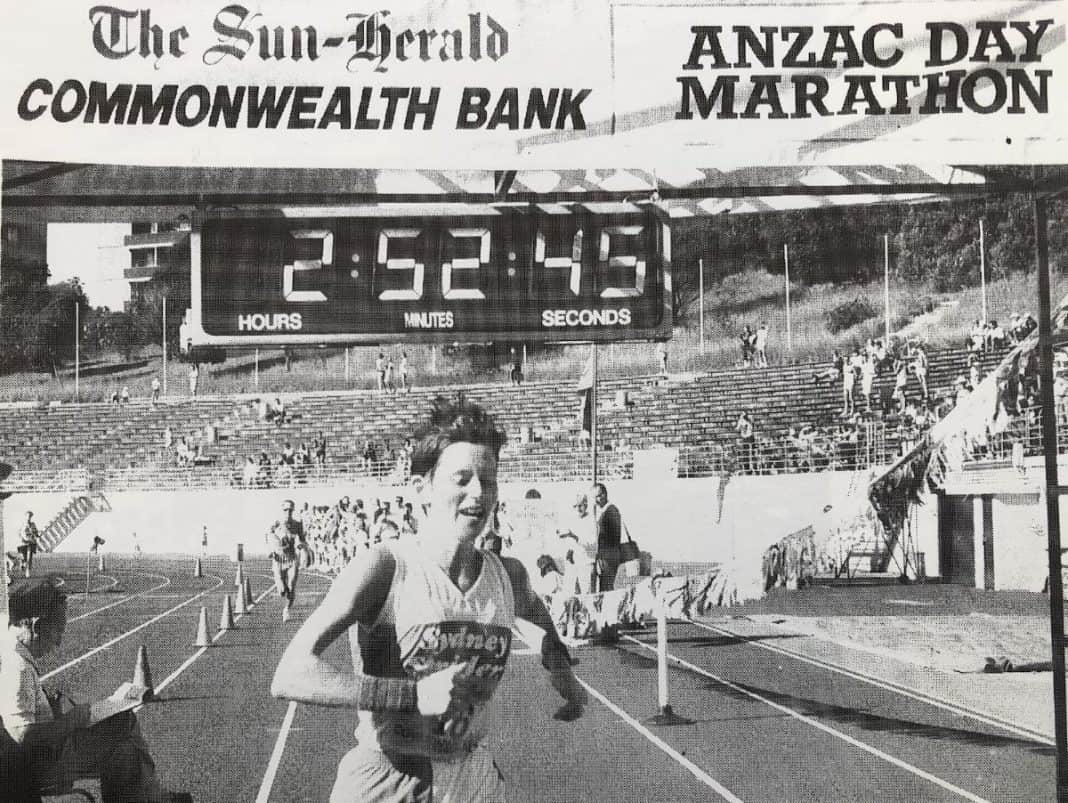
Around this time National Event Squad Management groups were being overseen by the Australian Institute of Sport (AIS), ‘membership’ requiring sub-2:20 performances for men and sub-2:50 for women. Jo was soon to join this exclusive ‘club’, though never became a member of the short-lived squad arrangement and received little contact from Athletics authorities. ‘I was on my own.’ As a result of her 1990 marathon performance Jo was offered a couple of trips to India to race marathons, which she declined, unconvinced of their value to her development.
4.1 Coach
It was during the trip to New Caledonia that Jo met NSW distance runner Annette Dwyer (prominent on the national scene as an Australian cross country representative), and at 34 years of age was linked to her first and only coach, John Atterton. John later coached Central Coast 800 metres exponent and multiple Australian Champion Nick Bromley. ‘He always said he was a middle-distance coach, rather than a marathon coach.’ However, his guidance and support was invaluable to Jo, both learning along the way. ‘He was my mentor, like a second Dad to me.’
Though better known as a middle-distance racer, John was an accomplished steeplechaser, winning the NSW title in 1960 (9:03.4) and 1962 (9:20), and finishing second in the 1961/62 Australian Championship in 9:02.6 behind Trevor Vincent’s 8:49.2. An ex-professional champion, and Oceania masters champion, John had wide ranging influence on the Sydney club scene as a coach and administrator, including occupying the role of President of Athletics NSW. At the time of Jo’s meeting with John, he was associated with the Eastern Suburbs Athletics Club, and facilitated club sponsorship from Seiko, his employer. Easts was to become Jo’s second club. John passed away in 2016.
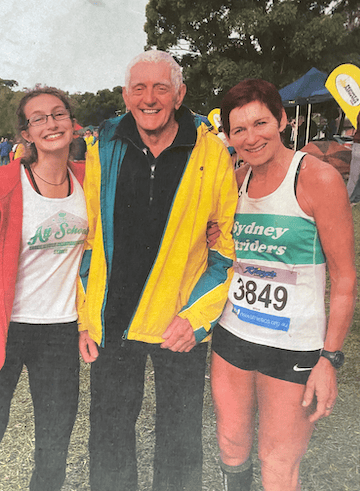
John’s wife, Nancy Atterton (nee Fogarty), was a sprinter in the 1950’s Australian golden era and coached Olympic sprinters Miles Murphy, Paul Greene, Pat Dwyer and Josh Clarke at different times in their careers. She is known to have a firm hand and no-nonsense approach to coaching.
4.2 Training and Racing Approach
Jo recalls that early in her coaching relationship with John she completed a session of 40×100. She clearly wasn’t a speed merchant, and John’s catch cry was ‘we’ll get you faster, lift those hips, your bum looks like its hanging on the ground.’ Throughout her career, John instilled in Jo the need to keep tall, focus on the hips and stride length, lean forward slightly but not too much, and engage the glutes. As evidenced by my introductory comments it is advice that remains with Jo to this day.
Around this time Sophie Scamps was also a member of John’s squad. Fifteen years younger than Jo, now in NSW politics, Sophie was a 400/800 metres exponent and a beautiful stylist, but ‘only trained twice per week.’ She was an Australian Junior 800 metres champion, placed second in the open event and represented Australia at the World Junior Track and Field Championships of 1986 and 1990. Jo and Sophie ran regularly on the North
Ryde Commons around the grounds of the Psychiatric Facility. There were plenty of hills that improved Jo’s strength.
4.2.1 Training
John introduced Jo to the track gradually and she developed slowly under his guidance. The art of peaking was paramount to John. Jo recalls completing a session of 20×400 100 jog and walk, one week before her 1994 Zatopek 10,000 metre race. She ran a great session and John was concerned that she had peaked too early. ‘Oh my God you have just peaked’ were his exact words, as they devised a strategy for her to hold form for another week.
Like many of her era, Jo loved Robert de Castella’s approach to training and racing and followed his book de Castella on Running (published 1984, co-authored with Gaylene Clews) to the letter in preparing for marathons. She recalls meeting Deek at a Striders awards night where he gave a speech. Her faith in Deek’s program drove her self-belief.
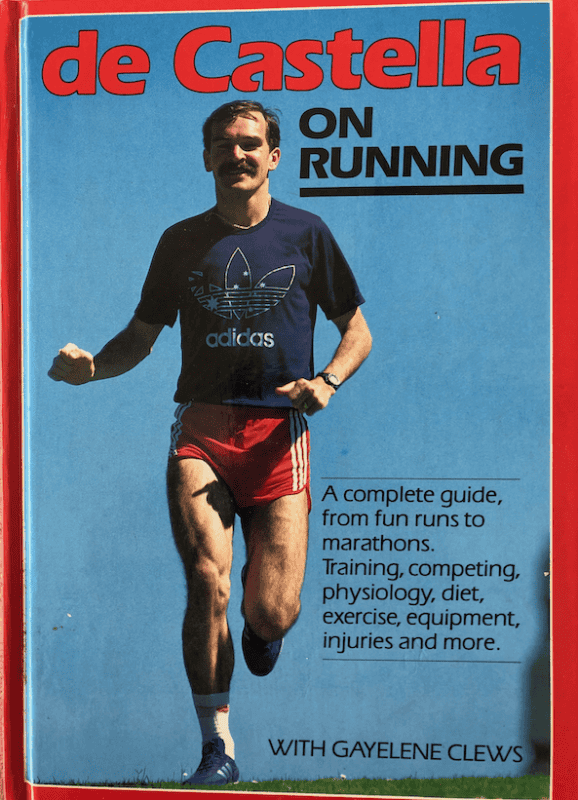
At her peak Jo’s weekly training schedule went something like this:
Monday: am 10km
pm 6-10km including speedwork at Centennial Park – reps on soft surfaces, weird distances
Tuesday: am 10km
pm track session
Wednesday: am 21km long run
pm 8km easy
Thursday: am 10km
pm 10km incl track session
Friday: am 10km easy or rest
Saturday: am grass hill running on North Ryde Common and solid rep session or race [during Summer did track races and in Winter competed in the West Metropolitan Race series – off road 4km or straight cross country]
Sunday: am 30km with Striders
Jo treated running marathons like a job. She never did a warm up for them, using the first couple of miles to ease into the race, part of her ‘take’ from the advice of Lydiard, as well as eating honey and doing hill reps. Jo was ‘focussed’, training 150 km per week, never junk miles, tired day in day out and working full time. To get the miles in she would often run from French’s Forest to her place of employment at North Ryde and run back in the evenings. Jo always did her 30km long run on Sunday mornings with the Striders, no matter what, but would never do another easy 7 or 8km in the evenings to ease the aches and pains, the way Wardlaw trained athletes seemed to do. She could run much faster than all the Striders men but always held herself back.
‘As far as training goes, I concentrated on my running and didn’t do weights, stretching or any other forms of exercise. With a fulltime job, heavy mileage and eventually a young child to look after, I couldn’t manage anything outside of that.’
4.2.2 Racing Philosophy
Jo loved racing and was tactically aware. She would have regard to her competitor’s abilities, assess the situation and devise a strategy to win. It was a brutal win at all costs attitude that she stuck to. Though often slower than her opposition she had a positive attitude of ‘what can I do today?’ Every race was a new opportunity to prove herself. Jo admitted to getting very nervous beforehand but the nerves always calmed once the race started. She would only race if adequately prepared. John often acknowledged Jo’s race readiness, and particularly her ability to come home strong towards the end, by calling out to Jo during a race ‘you’re going for the doctor today’. Alternatively, he would use this phrase as pre-race motivation, an affirmation that she was about to race well.
Jo had complete rest before major races, generally two to three days off for half marathons and marathons, and one day for a 10km. ‘This meant I was fresh and rested and champing at the bit to go.’ Though it piqued her interest Jo never tried carbohydrate loading. She had a massage every week, both as injury prevention and to assist rehabilitation. Her masseuse was Alan Nolan, a prominent Sydney coach. Jo proffered that she was ‘not biomechanically perfect but I worked on minimising the effects of tiredness.’
- Racing Highlights
Jo’s racing background is so lengthy, full of rich experiences, opportunity fulfilled and unfulfilled, ups and downs traversed. The consistency of her performances over many years is the standout. Her experience lends credence to the adage that she is truly a woman for all ages, racing competitively and placing in age group categories into her sixties. Examining her racing career with a critical eye, Jo acknowledges that the years 1992 to 1994 were her best years, the Tokyo Half Marathon in 1992 and Canberra and Gold Coast Marathons of 1994 being key events.
5.1 Tokyo Half Marathon
On 26 January 1992 Jo competed in the Tokyo Half Marathon, running a career best of 76:17. It was a great experience, and Jo couldn’t really believe the company she was keeping. She sat on the plane near Australian legend Steve Moneghetti. The field included Liz McColgan who Jo found easy to talk to during the post-race function, ‘a beautiful person and impressive in her encouragement of others’, Australians Lisa Ondieki and Lynn Clayton. The placegetters were McColgan (67:11), Ondieki (68:33) and Clayton (72:25), all running career bests. McColgan’s performance smashed Norway’s Ingrid Kristiansen’s world best of 68:32 and South African Elana Meyer’s time of 67:59 that was pending ratification.
Finishing eighth, Jo describes this race as her ‘miracle half’, one of those rare days when she was full of running. It was a mixed race with the men, a cold day and had been snowing. Unfortunately, the Association of Road Racing Statisticians (ARRS) have subsequently stated the course was not legal. The ARRS states that for the 1998 and earlier events the course was point to point and had a drop of 1.6 metres per kilometres. Performances for 1992-1997 are considered ‘excessively aided by the drop and probably by tail-winds as well, with race time biases faster than -5 sec/km.’ Monas won the men’s race in 60:27, a purported world best (Paul Arthur seventh in a gutsy 62:16). Monas and McColgan’s times are not included in the official world best progression listings and the race is not mentioned in McColgan’s biography, though Mona’s 1993 win in 60:06 is included in the world best listings with some annotation [Noted by the IAAF as set on uncertified or aided course which does not fulfill the criteria specified in IAAF Rule 260.28.b or 260.28.c.]. There is some inconsistency here as Ondieki, Clayton and Jo’s performances appear to be included as legitimate times in our national all-time rankings as do all our men’s performances at Tokyo prior to 1999.
Jo returned to Japan seven years later at 43 years of age to compete in the 1999 edition, finishing 21st in 77:29, behind Kerryn McCann’s third place 69:05. She has fond memories of bunking with Kerryn ‘my hero, who I adored’ and sharing the phone to call their children from their hotel room. Kerryn raced Tokyo again in 2000, repeating her third place of 1999 in an Australian record of 67:48. In both races Kerryn was beaten by South African Elana Meyer and Kenyan Esther Wanjiru in 66:44 and 66:49 (world best performances) and 67:33 and 67:41, respectively.
Whilst Jo ran under 80 minutes consistently in Australian events her two fastest times were achieved in Tokyo. Jo’s best half marathon performance within Australia was 77:50 finishing seventh in the Australian Championship event held at Lake Macquarie, NSW, in 1994. Jo raced this championship event on five occasions, 1992 to 1996, always running sub-80, her best placing being third in 1993 in 78:41.
5.2 City to Surf
During the 1980s Jo ran the City to Surf for fun. In 1992, aged 36, Jo ran her fastest City to Surf, finishing seventh in 50:26, repeating her highest placing of 1989. This was sandwiched between her third and fourth best times of 51:10 (15th in 1991) and 51:34 (9th in 1993). Her 1994 performance was below par after two exhausting marathon performances, 18th in 53:31. During November 1995 Jo gave birth to her only child, Nicola, and raced in the City to Surf that year whilst five months pregnant, finishing 20th woman outright in 54:02.
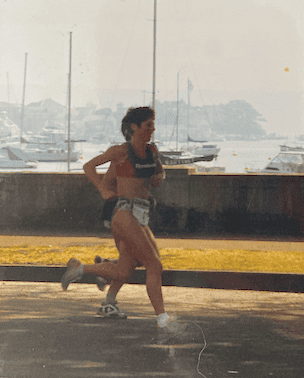
Jo reenergised for a couple of outstanding performances, running her second fastest ever at nearly 41 years of age in 1996 (50:28 and 9th overall) and finishing second in the W40 category to Susan Hobson in 2000, and 11th woman outright in 53:10, one month shy of her 45th birthday. Susan ran an outstanding 48:24 at 42 years of age to win the women’s event ahead of Krishna Stanton 49:37 and Sheila Fairweather 49:38. Jo continued to race the City to Surf most years placing highly in W50 categories and having her last run in 2019, aged 63.
5.3 Canberra Marathon
Jo raced the Canberra Marathon throughout the nineties, an event recognised for its excellent organisation on a course not known for superfast times. Though the course has changed over the years only three women have ever broken 2:40 and no man has bettered 2:15. Canberra was also the designated Australian Masters Championship, and by virtue of Jo’s performances she won the respective W35 and W40 categories every year that she competed. Given its history, her achievement to this day as the only four-time winner, man or woman, Jo’s record at Canberra is impressive:
1991 1st 2:46:18, (age 35), won by 9 minutes
1992 1st 2:42:31 (36) won by 2 minutes
1993 1st 2:42:00 (37) won by 6 minutes, also NSW Open Championship
1994 3rd 2:40:13 (38) 8 minutes behind winner and a career best
1995 1st 2:41:58 (39) won by 2 minutes
1997 2nd 2:44:16 (41) lost by 91 seconds
1998 2nd 2:52:00 (42) lost by 55 seconds
1999, 6th 2:58:44 (43) 11 minutes behind winner
The highlight race for Jo was the 1994 event. While 1994 was the year of the Victoria, British Columbia, Commonwealth Games her main goal was to beat the Olympic B qualifying time of 2:40 for the Atlanta Games. In the lead up to this race Jo ran 34:47.86 for tenth place in the December 1993 Zatopek 10,000 metres. One month before the marathon Jo finished fifth in the Australian 10,000 metres track championship in Sydney in 34:28.71, a career PB, though nearly two minutes behind the winner, Susan Hobson, 32:38.74.
Canberra was a disappointment and peak achievement all rolled into one. In terms of pre-race plans ‘I knew that Canberra local Sue Hobson and Kiwi Nyla Carroll were better than me so the 2:40 became my key focus.’ The race conditions were described in The Canberra Times as ‘perfect, a mild temperature, cloud cover, no humidity and no wind.’ Primed for this race, as always, Jo felt strong and full of running, similar to her experience in Tokyo. Jo explains that she was tracking for 2:37 most of the way, and whilst it felt tough during the race, she remained confident of hitting sub-2:40. Out on the course a bike rider friend was providing moral support and praised Jo, saying she was a certainty for the B qualifier. And though Jo was never on equal terms with Susan, she was ahead of Nyla until about 30km. However, upon hearing her friend’s comments Jo relaxed a bit too much and lost momentum, missing her goal by 13 seconds.
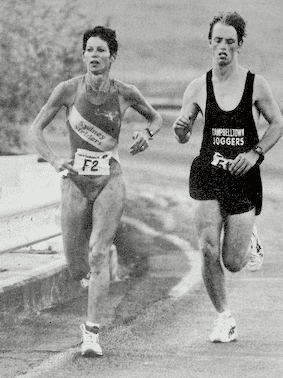
In her debut marathon, Susan won in a fast 2:32:57 in front of a supportive home crowd. She smashed Lisa Martin’s course record of 2:35:05 set in the 1984 Olympic trial race. Nyla Carroll was second to Susan in 2:36:21 and went on to represent New Zealand in the 1994 Commonwealth Games and 1996 Atlanta Olympic Games. Of note, she also won the 1995 Zatopek 10,000 metres. Nyla became the only woman to twice achieve a sub-2:40 in Canberra when she won it in 2003, 2:38:56, aged 37. Though a DNF in the Commonwealth Games marathon, Susan, coached by Pat Clohessy and already an Olympian, became a consistent 2:32-2:35 marathon runner. Susan competed in the 1992 and 1996 Olympic Games and capped her career with Australian representation at the 2000 Sydney Olympics (38th in 2:38:44 at 42 years of age).
Jo comments that Canberra was her first exposure to prize money, receiving $900, $1070, and $1350×2 for her 1991 to 1995 race winning performances and $825, $630 and $675 for her 1994 to 1998 second and third place outcomes. ‘Compared to men this was a pittance.’ However, over time she saw a shift towards greater equality, and actually received $5000 and a trip to Japan for her performance in the 1994 Gold Coast Marathon. Winning Canberra also attracted trips to the Gold Coast Marathon.
5.4 Gold Coast Marathon
The Gold Coast Marathon was designated the Australian Championship annually from 1988 to 1999 inclusive and attracted international women’s fields, providing stiff competition for domestic runners. Jo raced the Gold Coast Marathon three times in her career, with strong showings of fifth in 1991 2:46:44 (fourth Australian), sixth in 1992 2:46:41 (second Aust) and second in 1994 2:45:35 (first Aust).
Disappointed with her 1994 Canberra performance, in a last-ditch effort to achieve the B qualifying standard, Jo ran the Gold Coast Marathon three months later. Unfortunately, her performance was affected by an upset stomach, having consumed food that was off the night before. This meant excessive toilet stops during the first 10 kilometres of the race. On an extremely hot day Jo finished second in 2:45:35 to Japanese winner Yuko Yamazoe’s 2:43:20.
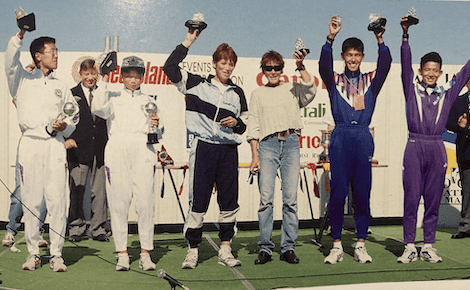
Lucas either side of Jo. Source: Gold Coast Marathon official pictorial:
‘The Race 1994’.
Though Jo ran a solid race under trying circumstances, and won the Australian Championship three minutes ahead of 47 year old South Australian Beverley ‘Bev’ Lucas, it was a frustrating outcome. Jo recalls this was the worse she ever felt in a marathon, suffering from severe dehydration and falling over the finishing line. ‘I couldn’t move. Whilst I had special drinks it just wasn’t enough. I don’t remember whether I ever got close to Yuko. I probably didn’t. I was so unwell I was just keen to get the race done.’ Jo wasn’t alone in this regard, the official results handbook stating that 30 people required treatment, with 12 needing drips to combat dehydration, three hospitalised, and two suffering from hypothermia.
Jo is complimentary of stalwart, Bev Lucas, who was a regular fixture on the Australian marathon scene. As a woman in her forties, she exhibited an outstanding level of consistency during the years 1990 to 1998. During this period ‘Bev’ ran 25 marathons under three hours, 13 being sub-2:50. She also placed in the Australian Championship every year from 1990 to 1997, second on six occasions. Her career best time was 2:43:45 finishing second behind Jo at Canberra in 1995. In 1997 at fifty years of age Bev ran 2:44:12 to finish second behind Susan Hobson’s 2:32:43 at the Gold Coast, setting an Australian W50 record that still stands.
At the end of a disappointing 1994, now aged 39, Jo rallied to finish the year on a comparative high note with a 34:32.18 14th place at the Zatopek 10,000 metres in Melbourne, won by Ondieki against a strong field in a fast 31:47.11.
- The Slow Down
After winning the Canberra Marathon again in 1995, Jo resumed heavy training post the birth of Nicola, and performed well in the 1996 Sydney Marathon 2:47:23 (11th) and 1997 Canberra Marathon 2:44:16 (2nd). For seven years she trained on a regular basis pushing her daughter in a baby jogger pram until she could do it no more. ‘Nicola was seven and getting too heavy’. While it proved useful as pseudo-strength training, it was unsustainable.
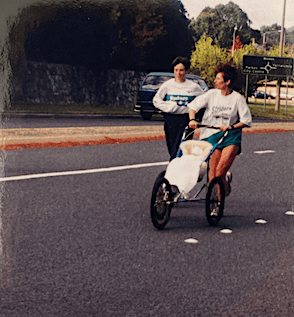
By 1998 Jo’s performances in track and road were declining, though she continued to run sub-80s in the half marathon (including a 78:52 in the 1998 SMH event and the previously mentioned 1999 Tokyo performance) and well under three hours for marathons until 2000.
Aged 43, Jo ran 36:11 in her third and last appearance of the Zatopek 10,000 metres in December 1998, finishing 15th only 30 seconds behind a promising 19 year old by the name of Lisa Weightman who placed 13th.
In a footnote to her open career Jo competed in the Australian Marathon Championship of 2000. Called the Host City Marathon, it was the Olympic Selection Trial held as a precursor to the Sydney Olympics to ‘road test’ the course. This proved to be Jo’s last marathon, an ignominious 30th place in 3:09:02 that brought the curtain down on any future attempts at marathon racing. Unfamiliar with physical changes to Sydney’s Olympic precinct, Jo walked into a concrete bollard just before the race started, badly damaging her right knee. By 30km the pain became too much and she ‘crawled’ to the finish, glad for it to be over. For the record, Susan Hobson secured her Australian singlet with a win in 2:35:20 ahead of Japan’s Eri Yamaguchi (seventh in the 2000 Olympics) and Victorian Sherryn Rhodes 2:42:15.
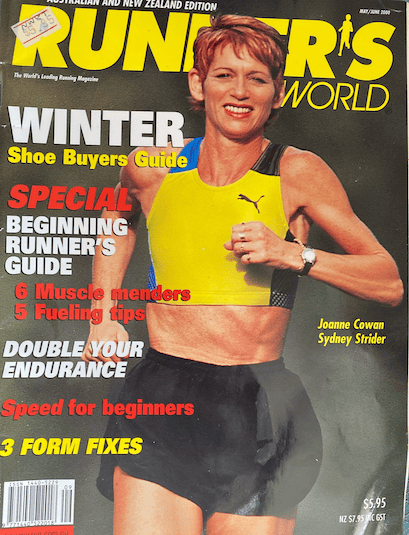
- A Reflection: Why Marathons?
As stated earlier, Jo loved running as an expression of freedom and as a vehicle for personal achievement. But why marathons? Jo describes it as a ‘personal challenge and a sheer joy. I was so fit and mentally prepared that it drove me to explore my potential. Each time I ran one I learned something about myself and it caused me to think about how much better I could be. Each completed marathon made me feel more infallible. This meant I had to take a step back at times. Once I overdid it and popped a calf muscle. I hurt during marathons but at the same time I wanted to make them a pleasure. And apart from the Gold Coast episode in 1994 and Sydney debacle in 2000, largely I succeeded. Though I have to say I never did more than two per year. I was on a mission to get more out of myself. That was the challenge. I was always on the cusp of greater achievement but never quite got there.’
- Concluding Comments
Poignantly, in her last competitive marathon Jo was unable to break three hours. However, Jo’s commitment to running has never waned. Similar to her attendance in the City to Surf, Jo’s innate desire to compete is epitomised by her regular involvement in the SMH Half Marathon. From its inception in 1992 when she ran third in 78:11, until 2019, Jo raced it on more than 20 occasions, only the advent of a heart condition and a worldwide pandemic preventing further participation.
Jo hasn’t really had any twilight years, rather it’s been a continuum of training and racing throughout her life, assisted by a strong association with the Sydney Striders, and the support of her family. Jo competed in domestic and World Masters events to a high level and while many of her past records have been swallowed up by such luminaries as Sydney’s Belinda Martin, Jo’s performances stand tall to this day. Like Susan Hobson and Beverley Lucas, Jo was a bridge between mature marathon running pioneers such as Dot Browne, to the current crop of elite mature racers of Lisa Weightman, Sinead Diver and Eloise Wellings, and largely raced against much younger competitors.
But as Jo said to me ‘I wasn’t in it for the money – what money? – or recognition. It was about the personal challenge of testing myself, the sheer joy that I derived from movement and the opportunity to mix with other like-minded individuals in a community setting. Sports people tend to have a more positive attitude to life and I wanted some of that.’
Jo gave her heart and soul to running and racing, and if you talk to anyone who knows Jo, you will appreciate how her example influenced the aspirations of women around her, younger and older, to strive for excellence, race hard and run free.
That is the essence of Jo.
Sources:
Association of Road Running Statisticians (ARRS): https://www.arrs.run
Ausrunning: https://ausrunning.net
Australian Athletics Historical Results/Athletics Australia Almanac: https://athletics.possumbility.com/almanac/index.htm
Bloom, M, Little Help Goes Long Way for Klecker, New York Times, 27 January 1992 – Tokyo Jan 26 (AP)
John Atterton: https://www.athletics.com.au/news/vale-john-atterton/
Hourigan, J, Canberra marathon winner wants to run for country, The Canberra Times, 11 April 1994
Moneghetti, S & Howley, P, In the Long Run, 1996, p166
NSW Amateur Athletic Association publication, 100 Years of the NSW AAA, The Official Centenary History of the NSW Amateur Athletic Association, 1987
NSW Masters records: https://assets.sportstg.com/assets/console/document/documents/0A0DE00E-5056-BD57-97185C9ADDF54EC5.pdf
and
https://www.nswmastersathletics.org.au/_files/ugd/b88fb5_3fe925116e3747799886e4b83f8aab2d.pdf
Quinlan, H, Now you can run – and you can Hyde, Sydney Morning Herald, 17 May 2008
Tokyo Half Marathon: https://www.arrs.run/HP_TokHM.htm
Wikipedia world half marathon progression:
https://en.wikipedia.org/wiki/Half_marathon_world_record_progression
Official websites of City to Surf, SMH Half Marathon, and Gold Coast Marathons
Recollections of Joanne Cowan during virtual meetings with author on 10 February 2023, 7 April 2023 and 21 April 2023.
Results Handbooks for Sydney Striders Half Marathon 1989 to 1994
Results Handbook of 7th Anzac Day Marathon, 1990
Results Handbook for Gold Coast Marathon 1994
Victorian Marathon Club (VMC) Newsletters, various